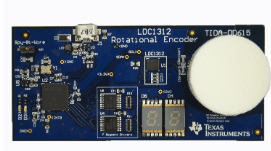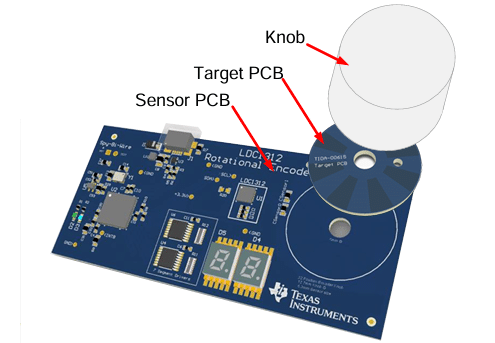Designed to withstand dirt, moisture, and oil, this solution eliminates wear-prone parts and avoids magnet reliance, enhancing longevity in automotive, appliance, and consumer electronics applications.

In traditional rotary control knob designs, mechanical contact-based systems have been commonly used, particularly in the Opara system. However, these mechanical systems often suffer from reliability issues due to wear and tear on moving parts, leading to costly replacements over time. Similarly, optical sensing alternatives, while contactless, are also vulnerable to environmental factors like dirt and dust, which impact their reliability in various automotive and industrial applications.
An innovative approach to address these limitations is an inductive sensing-based incremental encoder design. This design TIDA-00615 by Texas Instruments (TI) offers a contactless, robust, and cost-effective interface for control inputs. By leveraging inductive sensing technology, this solution functions effectively even in harsh environments where dirt, moisture, or oil might impede other sensing mechanisms. Notably, this design does not rely on magnets, further enhancing its durability and applicability across various sectors.

The inductive sensing-based rotary knob uses low-drift capacitive (LDC) technology to enable high-reliability position tracking without the need for recalibration. It operates within a 2.7V to 3.6V power range and consumes less than 3.5 mA of power (excluding power needed for the microcontroller and LED indicators). A distinctive feature is its flexibility, allowing the sensor and knob to be positioned remotely relative to the LDC1312/4 device. The design supports up to 32 steps per rotation and can be adjusted to accommodate multiples of 4 positions, offering versatility for various control applications. Additionally, it is capable of measuring rotations exceeding 1000 RPM with minimal computational requirements, needing only 40 bytes of RAM, 800 bytes of ROM/Flash, and 0.1 MIPS for a 5 ms response rate.
This rotary control knob design is well-suited for multiple applications, including infotainment systems in automotive settings, appliance interfaces (such as cooktops and cleaning devices), and home audio or consumer electronics systems. It also works effectively as a rolling jog wheel, making it a flexible option for various system control interfaces.
The LDC1312 component measures shifts in inductance as the knob rotates, converting these shifts into digital values that reflect the sensor’s inductance. These values are then retrieved by the MSP430F5528 microcontroller, which calculates the knob’s position based on the sensor data and updates the appropriate output, such as 7-segment displays. The LP5951 low-dropout (LDO) regulator plays a critical role in powering the system by converting the 5V USB input to a stable 3.3V output for the TIDA-00615 design. Compact in design, it ensures sufficient current output with a small SC70 footprint, ideal for space-constrained applications. Finally, a 7-segment display driver interprets the binary-coded decimal output from the MSP430F5528, driving each display segment to accurately represent the knob’s position.
TI has tested this reference design. It comes with a bill of materials (BOM), schematics, assembly drawing, printed circuit board (PCB) layout, and more. The company’s website has additional data about the reference design. To read more about this reference design, click here.






